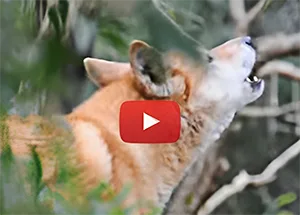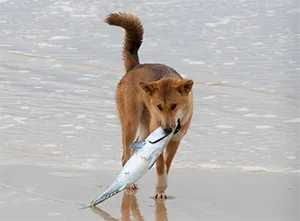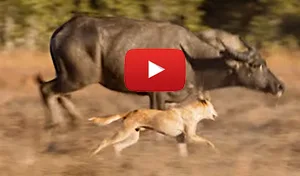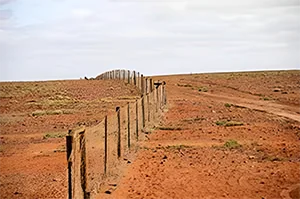Dingo Dog
Contents
What is a Dingo?
The dingo (Canis lupus dingo) is an Australian wild dog with a sleek body, pointed ears, and a bushy tail. It is a skilled hunter and scavenger that preys on animals such as kangaroos, rabbits, and birds. It is not an Australian native animal. Instead, it evolved from an early breed of semi-domesticated Asian dogs brought to Australia by ancient Asian seafarers about 4,000 to 5,000 years ago. A dingo may look like your pet dog, but is a wild animal.
What Does a Dingo Look Like
The dingo is Australia's largest land-dwelling carnivore. It is about 60cm tall, 150cm long, and weighs up to 25kg. Desert dingoes have red or yellow fur. Those in forests have a darker coat, with tan markings. Those living in the alpine regions are almost white and have bushier tails.
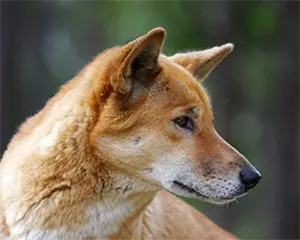
A dingo’s head is the broadest part of its body and can rotate 180 degrees in any direction. It has a pointed snout with large canine teeth. The dingo has erect ears and can move them independently of each other. It also rotates its ears backward. In addition, its sense of smell and sight is excellent. Dingoes are known for their intelligence and adaptability. They can survive in various environments, making them one of the most adaptable and successful predators on the Australian continent.
Unlike domesticated dogs, the dingo has highly flexible wrists similar to humans and can use its paws-like hands to grasp prey and even climb trees. Dingoes can run in short bursts of speed at up to 60 km/h and leap over 2-meter-high obstacles. They can travel up to 40km a day. The lifespan of a dingo in the wild is about ten years, and about 13 years for those in captivity.
How the Dingo Got Its Name
"Dingo" is a word from the Dharug language of the Aboriginal people living around Sydney to describe a native wild dog. Its first recorded use in English was in 1789 by Watkin Tench in his Narrative of the Expedition to Botany Bay.
Dingo Behaviour
Most dingoes are solitary, nomadic animals. However, a small percentage may travel in groups of 2-4 individuals, and a few may belong to family packs of up to 12 or so animals. These packs usually comprise an extended family with a dominant mating pair and their offspring from previous years. There is a dominance hierarchy (pecking order) among the pack's male and female members. These packs occupy territories that vary in size depending on the availability of prey. Dingoes mark their territory by urinating or defecating on the borders of their territories.
Dingo Habitat
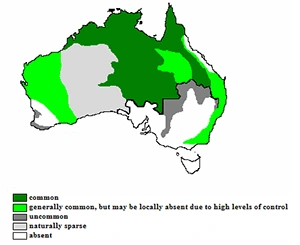
Photo: Dingo distribution map
Dingoes live in mainland Australia and can be found in various habitats, including deserts, grasslands, forests, and mountains. They prefer to live in areas with access to water and abundant prey, such as woodlands and grasslands that extend to the edge of forests. However, dingoes tend to avoid areas with high human activity, which is why they are mostly absent from many parts of New South Wales, Victoria, South Australia, and Western Australia. It's important to note that dingoes are not found on the island of Tasmania.
In desert regions, dingoes may dig their dens or burrows. In more temperate areas, they may make their dens in hollow logs, under large rocks, or commandeered wombat and rabbit burrows. Dingoes are highly territorial animals and will defend their territory against other dingoes or intruders, including humans.
Dingo Diet
Dingoes eat almost anything from kangaroos, wallabies, possums, rats, rabbits, birds, frogs, lizards, fish, eggs, and even insects and fruit. They also scavenge for carrion– the decaying flesh of dead animals.
Dingoes usually hunt wild animals. However, when food is scarce or the opportunity arises, they may also kill livestock such as calves, sheep, lambs, goats, and chickens. Dingos account for 1-7% livestock deaths. This makes them unpopular with farmers and pastoralists. Dingoes have also been known to kill domestic pets, such as cats and dogs, in areas populated by humans.
Dingoes hunt primarily at dawn or dusk when their prey is most active. They generally hunt alone but sometimes form packs to attack and bring down big game.
Dingo Reproduction & Life Cycle

Photo: Baby dingo pup
Dingoes breed once a year between March and June. Usually, only the alpha male and alpha female of the pack breed. All other members of the pack help to raise the pups. During the mating period, members of the pack become more territorial, using growling, barking and other dominant behaviour to defend their territory.
Dingoes are placental mammals and produce fully viable babies. The gestation period is approximately 63 days (similar to dogs), resulting in a litter of four to six pups. More male puppies are born than females. Pups are weaned at about two months and start to hunt for small prey. Pups reach adulthood at about seven months, when they may strike out independently or remain with their parents.
Male dingoes become sexually active at about one year, and females become sexually mature by two years of age. The life expectancy for a dingo in the wild is 5-6 years and about 15 years in captivity. Dingoes can interbreed with domestic dogs and produce viable offspring.
Dingo's Contribution to Extinction
The dingo was the first large placental carnivore to arrive on the Australian continent about 5,000 years ago. Since this time, there is clear evidence that two of the biggest native marsupial predators slowly became extinct. These are the Tasmanian tiger (Thylacine) and Tasmanian devil. These animals are referred to as ‘Tasmanian” because it was only on the island of Tasmania that they survived into recent times, because the dingo never reached this island. The extinction on the mainland occurred because the dingo was a far more efficient hunter/scavenger. As a result, it quickly out-competed its native counterparts and drove them to extinction. Many other species of Australian animals also became extinct after the the dingo's arrival.
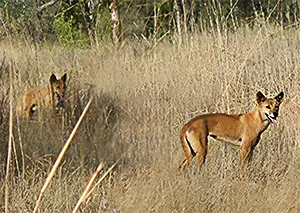
Photo: Dingo pack in Australian grasslands
Dingo's Impact on the Environment
Dingoes are not a threat to the Australian environment. They fills an important ecological niche. Being the only large carnivore left on mainland Australia, They keep the native kangaroo and wallaby populations in check. This function was once fulfilled by the Tasmanian tiger and Tasmanian devil, both of which became extinct on the mainland. Ironically their extinction may have been due to competition from the dingo. More importantly, the dingo also kills other introduced feral animals, such as the environmentally destructive rabbit, goat, and wild pig.
Dingo Predators & Threats
Adult dingoes have few nature predators. However, young dingoes may fall prey to crocodiles and birds of prey. The greatest treat to dingoes are humans. Farmers and pastoralists consider dingoes pests because they often attack and kill domestic livestock. As a result, dingoes are frequently targeted and killed through poisoning and shooting when they come too close to these properties.
Are Dingoes Endangered?
"Pure" dingoes are extremely rare. It is estimated that there are between 10,000-50,000 left. Because of interbreeding with domestic dogs and the subsequent dilution of its gene pool, there is a high probability that the "pure" dingo subspecies may become extinct. For this reason, the conservation status of the dingo is listed as vulnerable.
Dingo Attacks
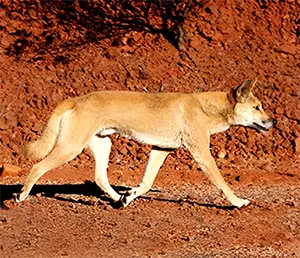
Photo: Dingo walking in Australian Outback
Dingoes are wild animals and typically avoid humans. However, dingo attacks do occur, from time to time, due to human behaviour, such as approaching, feeding, or trying to pet them. In rare cases, dingoes have attacked young children, probably mistaking them for prey. Most reported dingo attacks in Australia occur on Fraser Island, a popular tourist destination known for its dingoes. Despite warning signs, some visitors still engage in careless behaviour, leading to serious injuries. In 2012, a German tourist was attacked after wandering away from his camp-site and falling asleep on a track; he was set upon by dingoes and suffered serious injuries to his head, legs, and arms. Another man was attacked while walking alone on the beach at night. And a toddler was attacked after wandering away from her parents. While these incidents are very rare, they receive significant media attention.
Dingo Ate My Baby
The most famous case of a dingo attack was that of two-month-old Azaria Chamberlain who, her mother claimed was snatched by a dingo from their camp-site at Uluru in central Australia on 17 August 1980. This case was sensationalised by the media and Azaria's mother, Lindy Chamberlain, was demonised by the press which propagated the myth that she had killed her baby in some bizarre ritual. Lindy was tried, convicted of murder and jailed. Three years later, Azaria’s blood-stained clothing was discovered near a dingo’s lair with distinct tears most likely caused by a dingo’s claws, fangs, and teeth. A subsequent retrial found Lindy innocent of the murder, but by then her life and that of her family had been irreparably ruined – A clear case of the miscarriage of justice.
Dingoes as Pets
Dingoes are not domestic animals and are not suitable as pets. They are hard to train, unpredictable and have roaming nature. These animals require a lot of space and vigilance to be kept satisfactorily in captivity. The rules for owning a dingo vary from state to state. Victoria and the Northern Territory require a permit to own a dingo. New South Wales and Western Australia do not require a license. Owning a dingo in Tasmania, Queensland, and South Australia is illegal.
How the Dingo Came to Australia
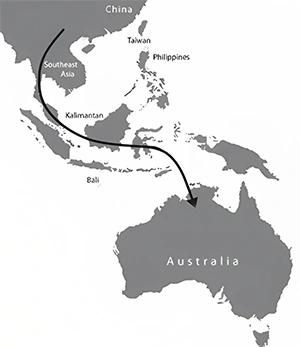
Photo: Possible route of dingoes to Australia
Evidence suggests that the dingo first appeared in Australia between 4,600 and 5,400 years ago. The prevailing theory is that ancient seafarers from Asia brought the semi-domesticated dog to Australia. While the dingo is often called a wild dog, it is considered a subspecies of the grey-wolf from South Asia. The dingo's close resemblance to the Asian wolf and native dogs found in many parts of Asia supports the theory that it originated in Asia, possibly Thailand. Some experts speculate that the entire dingo population in Australia may have originated from a single pregnant animal brought on an ancient vessel.
Interestingly, the dingo did not make it to Tasmania or other outlying islands off the coast of mainland Australia, indicating that it arrived after these islands were separated from mainland Australia by rising sea waters around 8-12,000 years ago.
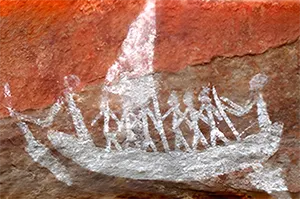
Photo: Rock painting of ancient seafarers
Is the Dingo a Native or Introduced Australian Animal?
The status of the dingo as a native Australian animal is a topic of some debate. While many consider it a native species, others argue that it was introduced to Australia by humans around 5,000 years ago. The distinction between native and introduced animals in Australia is based on whether the species was present before the arrival of humans. For example, animals such as kangaroo and koalas have been in Australia for millions of years and are thus considered native. However, since the dingo was brought to Australia by humans, it is not considered a native or indigenous species. Therefore, the dingo is an introduced Australian animal.
Dingoes and the Aborigines
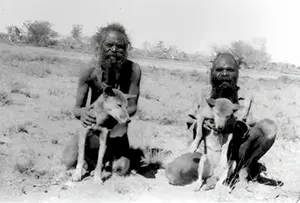
Photo: Aborigines with their dingo pets
Dingoes have been a part of Aboriginal culture for thousands of years. The arrival of dingoes on the Australian mainland was a significant event for the Aboriginal people, who quickly incorporated them into their societies and culture. Dingoes were used for hunting, protection, and companionship and were even given names such as "good kangaroo dog" or "good goanna dog". They also provided warmth at night, with some nights being described as a "two, three, or even four dog night". When Europeans arrived in 1778, they observed tamed dingoes living among Aboriginal communities. Some experts believe that dingoes became feral after the collapse of Aboriginal societies following European settlement.
Dingo Fence
The Dingo Fence is the longest fence in the world, and is over 5,600 kilometres long. Constructed in the late 19th century to protect livestock from dingo attacks, it remains one of the longest man-made structures in the world. While it has successfully kept dingoes out of the southern grazing lands, recent studies have shown that its exclusionary effects have led to unintended consequences. Kangaroo populations have increased, and feral foxes have become more prevalent in areas where dingoes have been excluded.
25 Dingo Facts
- Dingoes are wild dogs of Australia.
- They look like domestic dogs, but they are wild and can be dangerous.
- Dingoes are about half a meter tall and weigh up to 25kgs.
- They are lean, smart and agile animals.
- They can run short distances at up to 60kph, leaping 2m and can travel up to 40km in a day.
- The male is larger than the female.
- Dingoes living in hotter climates have short soft red/yellow fur.
- Those living in colder regions have more fur and are almost white.
- Dingoes rarely attack humans, but it does happen from time to time.
- There have been over 300 dingo attacks on humans since 1996. A few have been fatal.
- Dingoes are Australia's apex predator.
- Native apex predators, such as the Tasmanian tiger and Tasmanian Devil, become extinct because of the dingo.
- Dingoes are placental mammals, unlike most other Australian mammals.
- This is because they were brought from Asia sailors about 5000 years ago.
- The word "dingo" is a native Aboriginal name for this animal.
- The dingo's head is the broadest part of its body.
- It have pointy ears that it can rotate backwards.
- They hardly bark at all.
- The dingo has flexible wrists, like humans. It can also turn its head 180 degrees, twice as much as a human.
- Dingoes usual travel and hunt in packs.
- They don't like immersing themselves in water.
- Most dingoes will only wade water.
- They will not swim.
- You can own a dingo as a pet in some states in Australia. But it is not the smartest idea.
- The 5,600km dingo-proof fence is longer than the Great Wall of China.
Learn More About Australia's Incredibly Quirky Animals
All Rights Reserved. (Last Updated: May 15, 2025)

